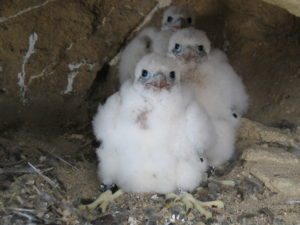NEST DEFENCE – Adult birds compete for nest sites, which can be in short supply in urban areas as the number of peregrines increases. Any intruders are chased off by the resident pair; territorial incursions may occur on a daily basis.
EGG-LAYING AND INCUBATION – Peregrines usually lay three or four eggs at two-day intervals, and begin incubating when the third or fourth is laid, for 29-33 days. The male takes over periodically to allow his mate to stretch her wings and eat.
YOUNG CHICKS – When they are newly hatched, the downy white chicks are totally helpless, and for a few days can’t see very much.

They are brooded to keep them warm, while the female peregrine tears meat into small pieces for them to eat.
OLDER CHICKS – The chicks grow rapidly, but are still brooded by the female peregrine. After three weeks the chicks start replacing down with juvenile feathers; by the time they are approximately five weeks old the birds are fully feathered.
FLEDGING – In their final days in the nest juvenile peregrines spend much of their time exercising their wing muscles, and often leave the scrape to explore nearby window sills or ledges. The birds finally fledge when they are about six or seven weeks old.
FIRST FLIGHTS – Recently fledged juveniles (which are browner above and heavily streaked) stay with their parents for another six weeks to learn to fly and hunt. Life is precarious: the many dangers include crash-landings in rivers and falling down chimneys or air vents.














